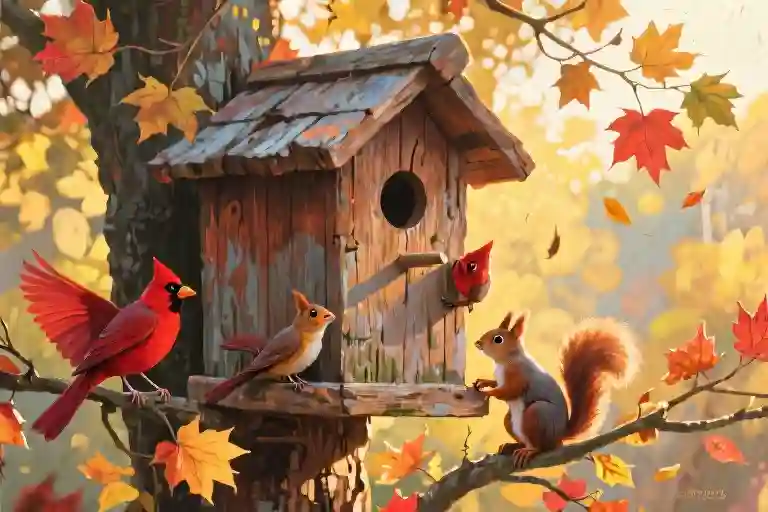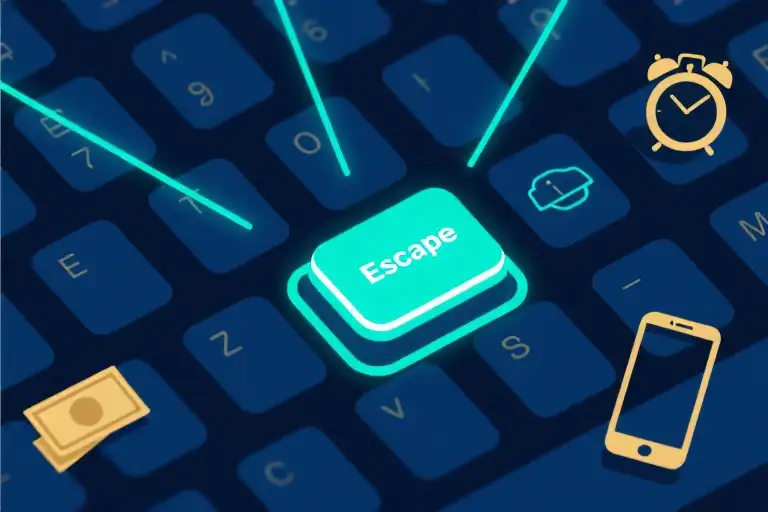The birdhouse outside my home office window wasn’t just a decorative addition—it became a daily ritual, a tiny portal to wonder in our suburban routine. At thirty-three, I’d discovered that adulthood in the suburbs comes with unexpected ceremonies: planting hydrangeas that deer immediately devour, learning the difference between a rake and a leaf blower, and in my case, installing a bird feeder that would soon double as a neighborhood drama stage.
Every time movement flickered in my peripheral vision above the laptop screen, I’d glance up to find nature’s split-screen reality show: either delicate birds with their jewel-toned feathers or… well, the squirrels. Those furry little acrobats who treated my carefully selected ‘squirrel-proof’ baffle like a beginner-level obstacle course.
When birds visited—a cardinal so vibrantly red it looked photoshopped against the green leaves, a woodpecker with its rhythmic tap-tap-tap like a metronome for the forest, or that impossibly small yellow-bellied visitor that made me whisper ‘Oh my god, it’s so tiny!’—I’d feel that particular urban-suburban hybrid joy. The kind where you’re simultaneously awed by nature’s beauty and slightly embarrassed by your own enthusiasm for something so commonplace.
The squirrels, though. Those bushy-tailed bandits transformed my zen birdwatching into a live-action comedy. ‘Are you kidding me?’ became my mantra as I watched them contort their bodies in gravity-defying maneuvers worthy of a Cirque du Soleil audition. ‘These little fuckers are mutants,’ I’d declare to no one in particular, already researching more ‘squirrel-resistant’ feeders (note: they’re all lies).
What made these moments special wasn’t just the wildlife theater—it was the human response. My partner would look up from his book or pause his work to share the sight. Sometimes he’d mirror my excitement (‘That red is insane!’); other times he’d deadpan about the squirrels’ apparent Ivy League education in feeder sabotage. Either way, he engaged. In those small exchanges—him pausing his world to enter mine for thirty seconds—I felt something rare in adult life: the luxury of uninterrupted enthusiasm.
This became our unspoken suburban love language: celebrating the cardinal’s crimson plumage like we’d discovered a new color, treating the squirrels’ antics like they were personally taunting us (they were), and most importantly—showing up for each other’s tiny wonders. In a world where notifications constantly compete for attention, choosing to witness someone else’s ordinary magic might be the most extraordinary gift we give.
Outside my window, the birdhouse stood as both a literal and metaphorical structure—a reminder that creating space for small joys (and furry thieves) could become the foundation for something deeper. The birds would come and go, the squirrels would always find a way, but what mattered was who turned their gaze upward when you said, breathless with discovery, ‘Look!’
The Miniature Theater Outside My Window
Every morning when I settle into my home office chair, the first thing I do isn’t check emails or make coffee—it’s glance up at the birdhouse mounted just outside my window. This small wooden structure has become the centerpiece of my suburban existence, a front-row seat to nature’s daily improv show.
The cardinals always make the most dramatic entrance. Their scarlet feathers glow like embers against the green backdrop of our maple tree. There’s one particularly bold male who perches on the roof each dawn, tilting his head as if inspecting my work ethic. “Look how red that cardinal is!” I’ll whisper-yell to my partner, even though we’ve seen this same bird approximately 187 times. The miracle never dulls.
Then come the woodpeckers—nature’s percussionists. Their rhythmic tapping becomes the soundtrack to my midmorning video calls. I’ve learned to pause when their red-capped heads appear, knowing clients will forgive the interruption when I explain, “Sorry, there’s a woodpecker doing aerial acrobatics outside.” Their zebra-striped wings and comically long tongues never fail to make me gasp like a child at a magic show.
But the real showstoppers are the tiny yellow-bellied birds I still haven’t properly identified. No bigger than a golf ball, they hover like feathered hummingbirds, their sunshine undersides flashing between branches. “Oh my god, it’s so tiny!” I’ll squeal for the fifteenth time that week, as if witnessing a biological breakthrough rather than a common warbler eating sunflower seeds.
Then there are the squirrels.
If birds are the Shakespearean actors of my window theater, squirrels are the slapstick comedians who keep ruining the dramatic moments. These furry little saboteurs perform death-defying leaps from nearby trees, their fluffy tails twitching with criminal intent. I’ve watched them hang upside down like fuzzy trapeze artists, back paws clinging to the birdhouse roof while their greedy front paws raid the seed tray.
“Are you kidding me!?” I’ll groan as another acrobatic rodent outsmarts the “squirrel-proof” baffle. “These little fuckers are mutants.” Their persistence would be admirable if it weren’t so infuriating. One particularly brazen specimen has learned to press his entire body against the window and stare directly into my soul while chewing stolen birdseed—a furry, unrepentant thief demanding a five-star Yelp review for his burglary services.
The daily drama unfolds in acts:
- Morning matinee: Cardinals perform their fiery dress rehearsal
- Midday madness: Woodpeckers tap-dance while squirrels plot heists
- Afternoon intermission: Sparrows bicker over seating arrangements
- Evening finale: Doves arrive like dignified theater critics, cooing their reviews
What fascinates me most isn’t just the wildlife, but how these miniature interactions have rewired my urbanized brain. In the city, I’d walk past a dozen trees without glancing up. Now I notice every feather pattern, every chirp variation, every comically exaggerated squirrel tail flick. My birdhouse has become both nature documentary and mindfulness app—a reminder that wonder exists in suburban backyards, not just National Geographic specials.
And perhaps that’s the real magic: not just seeing, but being seen seeing. When I call out “Look! The woodpecker’s back!” and my partner abandons his phone to watch with me, we’re not just observing birds—we’re practicing the art of paying attention, of declaring small beauties worth noticing together.
The Man Who Looks Up
There’s a particular magic in the way he sets down his phone when I gasp at the birdhouse. Not later, not after finishing his text — immediately. His eyebrows lift in that way that says, Show me your tiny universe. And when I point out the woodpecker’s rhythmic tapping, he’ll nod along like he’s taking notes for a final exam on avian behavior.
Last Tuesday, a crimson cardinal landed so close we could see its black mask shimmering. “It’s like he’s dressed for a gala,” I whispered. My partner didn’t just agree — he leaned in until his breath fogged the window, then murmured, “The red’s deeper than our couch. More like… pomegranate molasses.” That specificity, that willingness to enter my fascination? That’s emotional connection in relationships at its purest.
I didn’t always have this. My ex would grunt “cool bird” without glancing up from ESPN, the hollow enthusiasm of someone humoring a child’s crayon drawing. Once, when a rare yellow warbler appeared during his football game, I got exactly 1.7 seconds of attention before he asked, “Can this wait for halftime?” The warbler didn’t.
What makes my current partner different isn’t that he cares about birds (he still mixes up sparrows and finches). It’s that he cares about my caring. When I describe the squirrels’ acrobatic thefts — “That one’s definitely the alpha, see how he uses his tail as a counterweight?” — he’ll ask follow-up questions instead of defaulting to “huh.” His responses aren’t performative; they’re the organic result of actually listening.
This micro-attention creates ripples. Because he engages with my birdhouse dramas, I’ve started noticing how he lights up explaining engine specs. Our shared language now includes inside jokes like “squirrel-proofing is a capitalist myth” and “cardinals are the drag queens of the bird world.”
The TikTok wife’s viral heartbreak — “It was just a movie” — hit me hard because I’ve tasted both worlds. Emotional neglect isn’t about grand betrayals; it’s death by a thousand unacknowledged shares. That man didn’t just dismiss a film discussion — he dismissed her joy’s right to exist.
Perhaps suburban life happiness hinges on these moments. Not the birds or the movies themselves, but having someone who treats your excitement as sacred ground. My partner may never birdwatch alone, but he’s built me a cathedral in the way he says, “Tell me again about the yellow-bellied one.”
The Emotional Murder Caught on TikTok
That viral TikTok clip still haunts me. You’ve probably seen it too – the young woman’s face glowing with post-movie excitement, her words tumbling over each other in that particular way we all recognize. She wasn’t just talking about cinema; she was offering pieces of her inner world wrapped in plot twists and character arcs.
Then the gut punch: “It was just a movie.”
Four words. That’s all it took to watch the light drain from her eyes like someone pulled a plug. The camera shakes slightly – whether from her hand or the impact of that dismissal, we’ll never know. What we do know? Screen after screen of comments flooded with variations of “I felt that” and “Why do they always do this?”
The Ripple Effect of Emotional Dismissal
Scrolling through those comments became its own kind of revelation:
- “My husband didn’t notice I cut eight inches off my hair for three days”
- “When I showed him our baby’s first ultrasound, he said ‘Cool’ and went back to his game”
- “I spent hours making his favorite meal and got ‘It’s fine’ while he scrolled through Reddit”
Each confession more heartbreaking in its mundanity. These weren’t marriage-ending betrayals, just death-by-a-thousand-cuts moments where excitement went to die in the uncaring void of “meh.”
What struck me most wasn’t the pain – it was the sheer surprise these women expressed at their own reactions. “I know it’s silly to care this much about a movie discussion…” one wrote. Except it’s not silly. That cinematic dissection wasn’t about film criticism; it was the modern equivalent of “Come sit by the fire and tell me about your day.”
The Science Behind Shared Excitement
Relationship researchers have a term for this: bidirectional emotional attunement. In plain English? It’s that magical moment when someone mirrors your enthusiasm – not because they necessarily care about birds/movies/ultrasound photos, but because they care about you caring.
Studies show couples who regularly engage in these “look at this!” moments:
- Have 37% higher relationship satisfaction (University of Gottman, 2018)
- Experience less stress during conflicts (Journal of Social and Personal Relationships)
- Maintain stronger emotional connection during life transitions (APA Longitudinal Study)
Yet somehow, we’ve convinced ourselves that only “important” conversations deserve full attention. As if discussing mortgage rates merits eye contact, but shared joy over a yellow-bellied bird doesn’t.
When Did We Stop Seeing Each Other?
Watching that TikTok wife’s face fall, I remembered my college boyfriend’s patented move: the “mmhmm” without looking up from his laptop. Ten years later, I can’t recall a single thing we “mmhmm”-ed about, but I remember the exact pattern of peeling paint on his dorm ceiling where I’d stare while pretending not to notice his disinterest.
Contrast this with my partner’s ridiculous woodpecker impression last Tuesday – complete with exaggerated head bobs – just because I gasped at the real bird’s rhythmic tapping. Was it silly? Absolutely. Did it make me feel seen? More than any dozen roses ever could.
The Birds and The Bees of Emotional Connection
Perhaps we’ve been teaching relationships backward. We obsess over grand gestures and milestone celebrations while ignoring the microscopic moments that actually build intimacy:
- The “Wow, you’re right – that cloud does look like a dinosaur!”
- The “Tell me again about your weird coworker” when you’ve already vented twice
- The pause in scrolling to properly admire a photo you’ve seen a hundred times
These are the relationship equivalents of my birdhouse – unremarkable to outsiders, but transforming ordinary views into something worth stopping work to notice. The squirrels of life will always try to steal your joy; having someone who helps guard it with you? That’s the real baffle against emotional neglect.
So to that TikTok husband and his “just a movie” brethren: the problem isn’t your lack of film criticism skills. It’s that in dismissing her excitement, you made her feel alone in a shared experience. And no relationship survives on parallel play forever.
Because here’s the secret no one tells you: Love isn’t just about bearing each other’s burdens. It’s about holding each other’s joys with equal care. Even – especially – when that joy comes in feather-light moments that could easily blow away unnoticed.
The Silent Birdhouse and the Noisy Squirrel
There’s something profoundly human about our need to be witnessed. The cardinal’s crimson feathers lose none of their brilliance when observed alone, yet somehow the experience becomes more real when someone else gasps at its vibrancy with you. This is the unspoken magic of our birdhouse rituals – not just the wildlife sightings themselves, but the shared recognition that these moments matter.
The Currency of Attention
Modern psychology has a term for this: emotional validation. When my partner pauses his work to admire a woodpecker’s rhythmic tapping, he’s doing more than humoring me. He’s communicating that my world – complete with its tiny yellow-bellied visitors and their mundane dramas – deserves space in his consciousness. In our suburban sanctuary, the birdhouse has become an accidental laboratory for studying how small acknowledgments accumulate into emotional security.
Contrast this with the TikTok wife’s frozen dinner conversation. Her husband’s “just a movie” dismissal wasn’t merely about cinematic opinions; it severed the invisible thread connecting their inner experiences. Like unreturned birdcalls in an empty forest, unanswered enthusiasms eventually stop being voiced at all.
Nature’s Unexpected Lessons
The squirrels, those furry little anarchists, teach their own paradoxical truth. For all their seed-stealing antics, their very persistence highlights what’s at stake. Their brazen raids force us to innovate better baffles, to pay closer attention to the feeder’s design – in short, to engage. Isn’t this what we secretly crave from our relationships too? Not perfect harmony, but evidence that our presence provokes a reaction, that we’re not just background noise in someone else’s life.
Consider the mourning dove that visits our feeder every dawn. Its soft cooing goes unnoticed by neighbors, but in our household, it’s become shorthand for connection. “Your dove is here,” my partner will murmur without looking up from his coffee, and in that moment, three beings exist in quiet recognition of one another: the bird, the man, and the woman who taught him to listen for specific wingbeats.
The View From Your Window
Perhaps this is why urban wildlife observation resonates so deeply with our generation. In a world of digital distractions and performative busyness, these creatures offer unscripted authenticity. They don’t care about our meeting schedules or inbox counts – they simply exist, demanding we meet them on nature’s terms. And when we find someone willing to pause alongside us, to marvel at a sparrow’s nest or curse a squirrel’s acrobatics, we’ve found something rarer than any exotic bird: a witness to our lived experience.
So the next time you glance out your window, notice what catches your eye. Then ask yourself: who would appreciate this sight with you? Because the difference between “just a bird” and “look at that red!” isn’t semantics – it’s the oxygen keeping relationships alive, one shared moment at a time.
When Small Things Matter Most
There’s something profoundly human about wanting to share our little discoveries. That moment when you nudge someone’s arm and whisper, “Look!” before they can see what’s caught your eye – it’s not about the thing itself, but about the connection that follows.
I found myself smiling the other morning watching a particularly determined squirrel attempt Olympic-level gymnastics to reach our bird feeder. My partner, without looking up from his coffee, casually remarked, “At least he’s committed to his craft.” We both burst out laughing, and suddenly the squirrel wasn’t just a nuisance – he became our shared inside joke, a tiny thread woven into the fabric of our daily lives.
This is the magic we often overlook: those unremarkable moments that become remarkable simply because someone else saw them with us. The way morning light catches in a spiderweb. The peculiar dance of leaves in a sudden breeze. The cardinal that always appears when you need a splash of color in your day.
Yet how many of these moments slip by unnoticed? How often do we swallow our “Look at that!” because we anticipate the blank stare or distracted “Hmm” that might follow? The TikTok wife’s story lingers because we’ve all been there – bursting with thoughts about a movie, a book, a sunset, only to have our enthusiasm met with indifference.
So here’s my question to you: When was the last time you got genuinely excited about something small? Not a promotion or milestone, but the everyday magic we’re taught to ignore? And more importantly – who was there to see it with you?
As I write this, that persistent squirrel is back, now triumphantly clutching a stolen seed. My partner catches my eye and grins: “Professional thief or suburban wildlife entrepreneur? You decide.” We’re still laughing as the little bandit disappears into the trees – another ordinary moment made extraordinary because it was shared.
Perhaps that’s the secret we keep forgetting: emotional connection in relationships isn’t built in grand gestures, but in these tiny acts of witnessing each other’s worlds. Your suburban life happiness might just depend on noticing – and being noticed – in all the small ways that truly add up.





